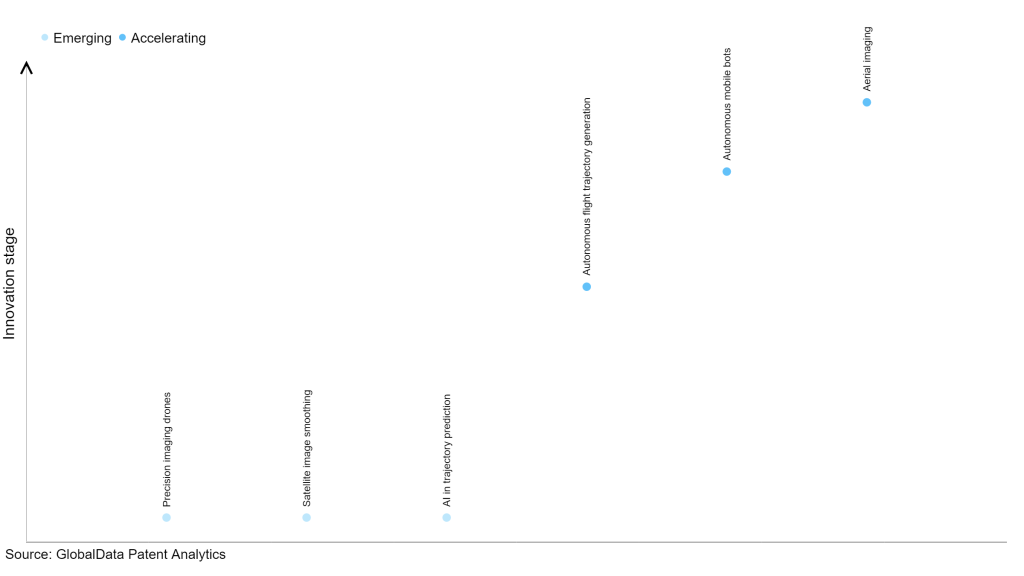The aerospace and defense industry continues to be a hotbed of patent innovation. Activity is driven by developments in artificial intelligence (AI) and machine learning, and growing importance of technologies such as drones, satellite technology, and big data. In the last three years alone, there have been over 84,000 patents filed and granted in the aerospace and defense industry, according to GlobalData’s report on Artificial intelligence in defense: surveillance AI. Buy the report here.
However, not all innovations are equal and nor do they follow a constant upward trend. Instead, their evolution takes the form of an S-shaped curve that reflects their typical lifecycle from early emergence to accelerating adoption, before finally stabilizing and reaching maturity.
Identifying where a particular innovation is on this journey, especially those that are in the emerging and accelerating stages, is essential for understanding their current level of adoption and the likely future trajectory and impact they will have.
110 innovations will shape the aerospace and defense industry
According to GlobalData’s Technology Foresights, which plots the S-curve for the aerospace and defense industry using innovation intensity models built on over 260,000 patents, there are 110 innovation areas that will shape the future of the industry.
Within the emerging innovation stage, precision imaging drones, aircraft maintenance AI, and AI video analytics are disruptive technologies that are in the early stages of application and should be tracked closely. Aerial imaging, autonomous flight controls, and surveillance AI are some of the accelerating innovation areas, where adoption has been steadily.
Innovation S-curve for artificial intelligence in the aerospace and defense industry

Surveillance AI is a key innovation area in artificial intelligence
Surveillance AI refers to the application of artificial intelligence technologies in surveillance systems for monitoring and analyzing visual data. It involves the use of advanced image analysis, pattern recognition, and machine learning algorithms to detect and identify objects, track movements, recognize individuals, and analyze behavior in surveillance footage. By automating the process of monitoring and analyzing video data, surveillance AI enhances the efficiency and accuracy of surveillance systems, providing real-time insights and alerts for various applications.
GlobalData’s analysis also uncovers the companies at the forefront of each innovation area and assesses the potential reach and impact of their patenting activity across different applications and geographies. According to GlobalData, there are 160+ companies, spanning technology vendors, established aerospace and defense companies, and up-and-coming start-ups engaged in the development and application of surveillance AI.
Key players in surveillance AI – a disruptive innovation in the aerospace and defense industry
‘Application diversity’ measures the number of applications identified for each patent. It broadly splits companies into either ‘niche’ or ‘diversified’ innovators.
‘Geographic reach’ refers to the number of countries each patent is registered in. It reflects the breadth of geographic application intended, ranging from ‘global’ to ‘local’.
Patent volumes related to surveillance AI
Source: GlobalData Patent Analytics
Boeing is one of the leading patent filers in surveillance AI. The company has filed patents related to a method and equipment for automatic tracking and detection of objects and activities through live video feeds. The method utilizes computer vision, natural language processing, and machine learning to identify and process objects and activities. Subsequently, the apparatus generates natural language text describing a storyline based on the identified elements. The output, comprising the generated text, can be presented audibly or visually alongside the live video feed.
Canada signed a deal with the US government to procure up to 16 Boeing's P-8A Poseidon aircraft, as part of the Canadian Multi-Mission Aircraft (CMMA) project, in November 2023. P-8A Poseidon is a multi-mission maritime patrol aircraft with anti-submarine and anti-surface warfare, and intelligence, surveillance, reconnaissance, and search and rescue capabilities.
Some other significant patent filers in the surveillance AI space include Microsoft, Amazon.com, and International Business Machines (IBM).
In terms of application diversity, Microsoft, Trax Technology Solutions, and Okada are some of the leading innovators. By means of geographic reach, some of the leading patent filers include ATSR, Accenture and Microsoft.
To further understand the key themes and technologies disrupting the aerospace and defense industry, access GlobalData’s latest thematic research report on Artificial Intelligence (AI) in Defense.
Data Insights
From

The gold standard of business intelligence.
Blending expert knowledge with cutting-edge technology, GlobalData’s unrivalled proprietary data will enable you to decode what’s happening in your market. You can make better informed decisions and gain a future-proof advantage over your competitors.



